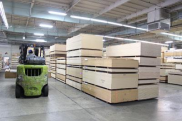WHAT THE PROS KNOW: PANEL CORES
You came in to our store just needing “a sheet of plywood”, and we’re grilling you like a rich Hollywood star who bribed their kid into Harvard: “What grade do you want? What core do you want? Plainsawn? Rift Sawn? Quartered? 18 millimeter? ¾ inch? Huh? Huh? Whaddaya want?
Sorry, we can be so picky! But we want you to be happy. Let’s start with…
The Core of the Panel: It Matters. A Lot!
The “core” is the substrate, the middle of a plywood sandwich. And it’s really important. These little bits of knowledge are what separate the pro from the do-it-your-selfer (like me!).
Veneer Core (“VC”)
Take layers of thinly-sliced lumber, glue them up properly, slap some attractive veneers on the outside and you got yourself a “plywood sandwich” that we call a veneer-core panel. If you hear “plywood”, this is what most people are thinking about.
The expensive and pretty face veneers are laid on top of the odd-numbered internal layers, which have been glued in alternating directions.
WHAT’S GOOD ABOUT IT? Light weight. Holds screws great. Glues really well. Better “spanning” properties than other types. Dimensionally stable (the alternating layers resist stresses simultaneously in opposite directions).
WHAT’S BAD? Veneer core panels will have more variances in thickness than other types. But the bigger concern is that, well, it’s not flat. Sure, it looks flat to the naked eye, and once you put the face veneers on, it sure looks smooth. But the grain of those veneers under the faces are anything but flat: they’re grainy. And after you’ve finished the project you might see that wood grain “telegraph” through the face veneers. (By the way, technological improvements have allowed face veneers to get thinner and thinner, exacerbating this problem).
Does it matter? Lots of beautiful projects have been completed with veneer core panels. It depends on what your project is, and only you can decide that.
ALL PLYWOOD IS NOT CREATED EQUALLY: READ THIS
Particle Board Core (PB or PBC)
Particle board consists of irregularly-sized bits of wood that are glued together and formed into sheets with very flat faces and uniform thicknesses.
WHAT’S GOOD? PBC is the least expensive choice of panel cores. The thickness is reliably consistent there are rarely any voids, and the faces are quite flat for applying face veneers.
Okay, now give me the BAD NEWS. It’s heavy. 1/3 heavier than veneer-core panels. It has the worst structural (spanning) strength of all the cores, and it expands like crazy when exposed to moisture. It also chips and tears rather easily.
So, we find PBC panels in price-sensitive fixtures and low-end furniture (frequently served with Swedish meatballs). And, yes, it does show up in some kitchen cabinetry.
MDF Core
Medium-Density Fiberboard, like Particle Board, produces extremely flat panels of very uniform thickness. Unlike particle board, MDF is made from fine wood fiber and can be milled and shaped very well, so we see it in mouldings and on projects where elaborate shapes are required.
THE GOOD: When applying hardwood veneers to the surface of MDF substrates, there is no concern for wood grain to “transmit” through the face veneers, which happens with veneer-core panels. Therefore, MDF-Core Hardwood panels are frequently used in high-end cabinet and furniture applications.
One downside of MDF is that it is heavy, so it presents concerns for upper, hung cabinets. Water and moisture are problems for highly absorptive MDF, and it does not hold screws very well.
Combination Core (CC)
Reese’s Peanut Butter Cups. Best of both worlds: Chocolate AND Peanut Butter. That’s Combination-Core. Thin MDF layers are bonded to a central “plywood” sandwich. After that pressing, the face veneers are glued on the outside. Some trade names you might hear are ArmorCore, ClassicCore, ProCore.
THE GOOD: Flat. Uniform thicknesses. Lighter than MDF or Particleboard. Stronger, greater bending/spanning properties. Loves glue. Holds screws really well because of the plywood center. The grain of the internal plies can’t telegraph thru the face veneers due to the MDF layers.
And let’s talk about that last item. As technology has improved, manufacturers are able to slice the face veneers thinner and thinner. Which makes panels more and more susceptible to sand-through. Because the MDF layer ensures that the face is very flat, you need hardly any sanding to get your surfaces prepped for finishing. That is a huge advantage.
SO, WHAT’S NOT TO LIKE? Price. Combination Core panels are 10-20% more expensive than MDF-core. Which is a bargain compared to ruining a project because you just sanded right through the face veneers of a nearly completed project. We know; we’ve been there.
Lumber Core
We’ll mention Lumber Core here, though you would rarely see it at Valencia Lumber, if ever, because it doesn’t lend itself to the creation of high-end cabinetry and furniture, which is the world our clientele occupies.
Lumber core is made from strips of solid lumber edge-glued together to form a flat panel. A veneer crossband is applied to that, followed by face veneers. You’ll see it in imported furniture or closet shelving, it’s typically 18mm. It holds screws really well (hey, it’s solid lumber inside), and has great bending strength.



